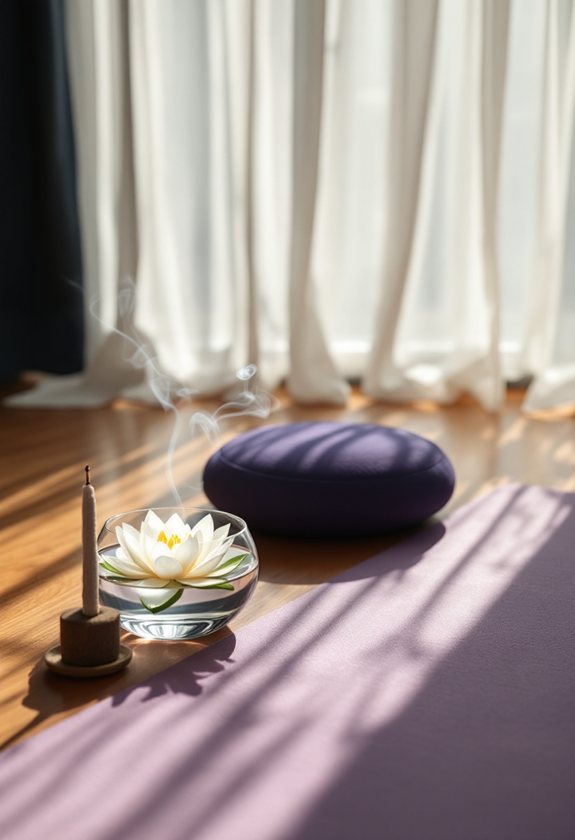You can release daily tension through five powerful mindfulness practices that take just minutes to perform. Start with mindful breath awareness to calm your racing thoughts, then use body scanning to release physical tension. Ground yourself through sensory engagement exercises when feeling overwhelmed, incorporate mindful movement like walking or yoga to reconnect with your body, and practice heart-centered meditation to cultivate emotional balance. These transformative techniques will guide you toward lasting inner peace.
Key Takeaways
- Practice mindful breath awareness by focusing on your breathing patterns to reduce stress and anchor yourself to the present moment.
- Perform regular body scanning exercises while lying down to identify and release physical tension throughout your body.
- Use the 5-4-3-2-1 grounding technique to engage your senses and immediately reconnect with your surroundings during stressful moments.
- Engage in mindful walking or yoga to synchronize breath with movement and release physical tension.
- Practice heart-centered meditation to cultivate emotional well-being through gentle breathing and positive visualization.
The Power of Mindful Breath Awareness
While many people search for complex solutions to manage stress and anxiety, the simple act of mindful breath awareness stands out as one of the most powerful tools available.
You'll uncover that diverse breath techniques can help you find emotional balance throughout your day.
When you focus on your breath, you're tapping into a scientifically proven method for reducing stress and improving concentration.
Your breath becomes an anchor to the present moment, helping you step away from worrying thoughts.
You can practice this anywhere – at your desk, during your commute, or before a significant meeting – making it a practical tool for daily tension release.
Body Scanning: A Journey to Inner Calm
As you voyage deeper into mindfulness practices, body scanning emerges as a powerful technique that can transform your relationship with stress and tension.
Body scanning opens a gateway to mindful living, helping you discover new ways to release tension and find inner peace.
This simple yet profound practice invites you to develop deeper body awareness by systematically exploring sensations from your toes to your head.
You'll find that body scanning naturally encourages emotional acceptance as you notice different physical sensations without judgment.
Start by lying comfortably with your eyes closed, taking deep breaths, and gradually moving your attention through each part of your body.
When your mind wanders, gently guide it back to the present moment.
Grounding Techniques for Present-Moment Relief
When life's challenges leave you feeling overwhelmed, grounding techniques can serve as your anchor to the present moment.
Through sensory engagement, you'll uncover powerful tools to regain your center and find immediate relief from stress and anxiety.
Start by practicing the simple yet effective 5-4-3-2-1 technique.
Look around and name five things you can see, four things you can touch, three things you can hear, two things you can smell, and one thing you can taste.
This emotional anchoring exercise helps you reconnect with your surroundings and gently guides your mind back to the present moment.
Mindful Movement for Stress Release
Through the practice of mindful movement, you'll uncover a powerful way to release stress and reconnect with your body's natural wisdom.
Start with simple mindful walking, focusing on each step as you synchronize your breath with your movement. Notice how your feet connect with the ground and how your muscles respond with each stride.
Consider exploring yoga benefits that extend beyond physical flexibility. As you move through gentle poses, you're activating your body's natural relaxation response.
Your breath deepens, your muscles release tension, and your mind becomes clearer. These mindful movements create a bridge between physical awareness and emotional well-being.
Heart-Centered Meditation Practice
Heart-centered meditation offers a powerful complement to mindful movement, bringing your awareness inward to cultivate deep emotional well-being.
By focusing on your heart chakra, you'll tap into feelings of love, compassion, and inner peace through gentle breathing practices and positive visualization.
Connect with your heart's deepest essence through mindful breathing and visualization, awakening your natural capacity for love and serenity.
Start by finding a quiet space and sitting comfortably.
Place your hand over your heart, breathe deeply, and imagine warm, loving energy radiating from your chest.
This practice strengthens your emotional intelligence while releasing tension from your body and mind.
You'll notice improved relationships, reduced stress, and a greater sense of balance in your daily life.
Frequently Asked Questions
How Long Should I Practice Mindfulness Before Seeing Noticeable Results?
You'll notice improvements with consistent mindfulness practice in as little as 5-10 minutes daily. Within 2-3 weeks of regular practice, you'll experience noticeable changes in your stress levels.
Can Mindfulness Exercises Worsen Anxiety in Some People?
Yes, you can experience increased anxiety if mindfulness triggers uncomfortable emotions. Watch for negative anxiety responses, and if they occur, speak with a mental health professional for guidance.
What's the Best Time of Day to Practice Mindfulness?
You'll find your ideal time through experimentation. Morning routines can enhance alertness and start your day positively, while evening reflection helps wind down, but choose what fits your schedule and feels most comfortable.
Should I Practice Mindfulness With My Eyes Open or Closed?
You can practice effectively with eyes open or closed—try both to see what works best. Eyes closed reduces distractions for beginners, while eyes open helps prevent drowsiness and mirrors daily life.
Can Mindfulness Help With Chronic Physical Pain Conditions?
You'll find mindfulness benefits your chronic pain management considerably. It reduces pain intensity, helps you regulate emotional responses, and improves your quality of life through regular meditation and breathing practices.
Conclusion
You've now learned five powerful mindfulness practices that can transform your daily experience with stress and tension. By incorporating breath awareness, body scanning, grounding techniques, mindful movement, and heart-centered meditation into your routine, you'll develop a stronger connection with your inner calm. Start small, be patient with yourself, and watch as these simple practices help you cultivate more peace and presence in your everyday life.







